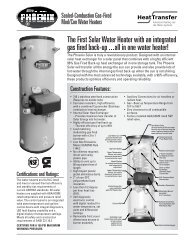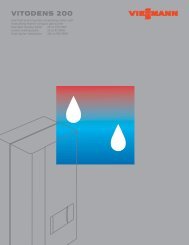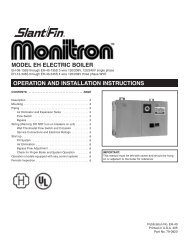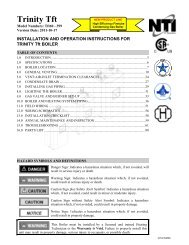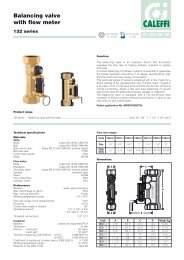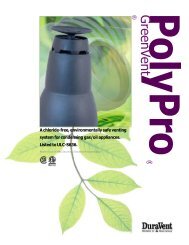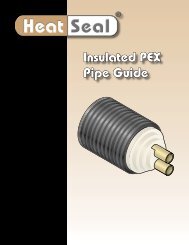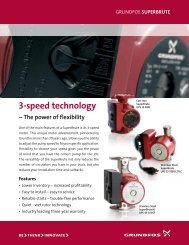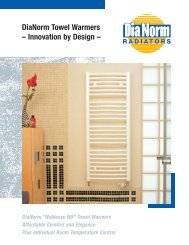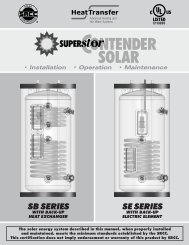Apricus Solar Water Heating System Installation and Operation ...
Apricus Solar Water Heating System Installation and Operation ...
Apricus Solar Water Heating System Installation and Operation ...
Create successful ePaper yourself
Turn your PDF publications into a flip-book with our unique Google optimized e-Paper software.
<strong>Apricus</strong> <strong>Solar</strong> Collector <strong>Installation</strong> & <strong>Operation</strong> Manual - USANOTICEDo not install the heat pipes <strong>and</strong> evacuated tubes until system plumbing iscompleted, the solar loop is charged, the pump <strong>and</strong> controller are operational <strong>and</strong>fluid is currently circulating (set controller pump function to ON) unless the system(in particular insulation) is designed to withst<strong>and</strong> high temperature stagnation orthe tubes are covered.WARNINGSafety glasses <strong>and</strong> leather gloves must be worn at all times when h<strong>and</strong>lingevacuated tubes <strong>and</strong> heat pipes. Never touch the inside of evacuated tubes or theheat pipe tip after exposure to sunlight.5.7.1. Heat Pipe Preparationa) Shield from Sunlight: Do not remove the tubes from the box <strong>and</strong>/or expose the tubes to sunlight untilready to install, otherwise the heat pipe tip will become hot enough to cause serious skin burns. The outerglass surface should not become hot. Ideally, transport the tubes close to the bottom of the ladder or otherroof access while still in their boxes. (Do not obstruct safe access.) There, the tubes can be be removed thebox <strong>and</strong> prepared on the ground, before being taken up to the roof for insertion. NOTE: At this point, it isoften helpful to cut the top 12” (30 cm) or so off the evacuated tube box, in order access the heat pipe bulbsfor preparation without exposing the entire length of the tube to sunlight.b) Damaged Tube: If an evacuated tube is damaged for any reason (E.g. knocked heavily or dropped), itwill need to be replaced. Either use another tube with heat pipe already inserted or if a plain evacuatedtube spare is being used, carefully remove the heat pipe from the broken tube <strong>and</strong> insert into the new tube.This should be done with care, holding the heat transfer fins in place with one h<strong>and</strong> while inserting the heatpipe by making a short pushing <strong>and</strong> twisting action. Never throw heat pipes away, as they are very sturdy<strong>and</strong> will not be damaged even if the tube has been. They can be kept as spares or inserted into plain spareevacuated tubes.NOTICEThe powder content of the heat transfer paste may have settled during storage <strong>and</strong>freight. In order to ensure optimal thermal conductivity, it is advisable to sit thetube (cap downward) in a glass of warm water (particularly in cool weather) toallow the powder to mix through. This will also allow the paste to become thinner,making application <strong>and</strong> heat pipe insertion easier.c) Heat Transfer Paste: While holding the spring plate in place, pull the heatpipe out of the evacuated tube by about 3” (8 cm). Using the heat transferpaste, form a thin layer over the heat pipe head (not the top round end). Thisis easiest to do using a short length of insulation pipe. Squirt some of the heattransfer paste into the insulation, the use to coat each heat pipe tip with a thinlayer <strong>and</strong> remove any excess from the tip. Using this method half a tube cancoat 30 tubes.d) Shake: Heat pipes contain a small amount of copper powder, which aids inheat transfer <strong>and</strong> provides freeze protection within the heat pipe itself. Toensure that the powder is at the bottom of the heat pipes, where is needs tobe, before installing the tube <strong>and</strong> heat pipe, they should inverted (Fat bulbdown), returned upright (Fat bulb at top) <strong>and</strong> then shaken up <strong>and</strong> down a fewtimes to ensure the powder has all returned to the bottom. This should beCopyright 2011 – <strong>Apricus</strong> Inc Doc: A7-05.4.1.4-PB-1.9 Page 50 of 126



